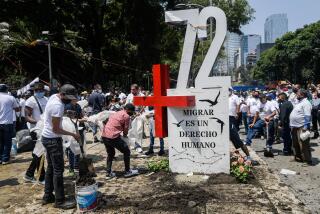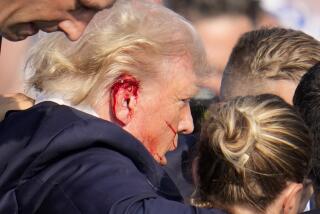Mexico Launches Probe Into Slaying of Bandit at Border : Controversy Over Coroner’s Office Reignited
- Share via
Star-shaped cuts surrounding the bullet wound that killed a Mexican border bandit during a gunfight with police and Border Patrol agents probably should have prompted a San Diego County coroner’s pathologist to study whether the man was shot at close range, not from the 30 feet claimed in the police account of the shooting, according to pathologists interviewed Thursday by The Times.
The coroner’s autopsy, performed May 6 by Dr. David Katsuyama, has become the center of a controversy over whether the bandit--Julio Arroyo Zaragoza--was killed in the gunfight or was executed by police as he lay wounded and helpless on the ground, as his brother and a San Diego attorney contend.
That charge of a close-range shooting was buttressed this week by a second autopsy performed on Arroyo’s exhumed body by Tijuana coroner Gustavo Salazar and further tests conducted in a San Diego laboratory by Dr. Hormez Guard, a forensic pathologist who used to work for the San Diego coroner. Salazar and Guard both said they found gunpowder under the surface of Arroyo’s skin, evidence of a shot fired from a gun resting on or very near the victim’s head.
Katsuyama’s autopsy on Arroyo is the latest in a series of cases that has raised questions about the quality of work in the county coroner’s office. Those questions have prompted local pathologists and attorneys to call on the county Board of Supervisors to replace the coroner’s office with a medical examiner, where a doctor would oversee the operation and have final say on all medical issues.
Katsuyama, a private pathologist who performs autopsies under contract with the county, reported finding “stellate,” or starlike, disruptions in the skin around the bullet wound in Arroyo’s forehead. Although such disruptions are considered a classic indicator of a point-blank wound--caused by gases building up beneath the flesh and then exploding--Katsuyama failed to preserve samples of the tissue directly beneath the wound and did not study samples he took of the bullet’s path through Arroyo’s brain.
“If I see a star-shaped bullet wound, then I’m going to think of the possibility of a contact wound and probably look further under the microscope,” Dr. Werner Spitz, chief medical examiner of Wayne County (Detroit) Michigan, said in an interview. “I would expect a pathologist to take a specimen from underneath there.”
Spitz said he recommends that pathologists take samples of tissue whenever a question about a wound might arise, because it is difficult to find evidence of gunpowder from an exhumed body, as Guard said he has done.
“If you overlook one step, if you didn’t do it correctly, it may be the only evidence you have, and it may be destroyed,” he said.
Dr. Warren Lovell, chief medical examiner in Ventura County, said stellate disruptions around a bullet hole are almost synonymous with contact wounds.
“That’s contact until you prove otherwise,” he said.
Guard, who resigned from the coroner’s staff of contract pathologists in 1984 and has since been a constant critic of the operation, said Thursday he believes the Arroyo case is an example of the poor technique used by the office, where even Coroner David Stark has admitted that his doctors are overworked and often forced to spend too little time on each autopsy.
Guard’s dispute with Stark centered on Guard’s belief that pathologists who perform autopsies for the county should be allowed to use more aggressive techniques in their search for the cause of death. In this case, for example, Guard argues that the pathologist should have visited the scene of Arroyo’s death and examined his body fully clothed and before it was cleaned.
“If I was the pathologist, I would have removed the wound and taken material from the wound to demonstrate the presence or absence of gunpowder within the skin,” Guard said. “I would have taken the skull, the dura mater, and demonstrated the deposition of powder on the dura. And I would have demonstrated gunpowder on the surface of the brain where the bullet entered.
“The entire track of the bullet would have been examined. None of this was done.”
But Stark, who said Thursday he would welcome an impartial re-examination of the case, said he stands by the original report of Katsuyama, whose work has been criticized in the past by the district attorney’s office.
“It had characteristics of a stellate wound but it was not a true stellate wound,” Stark said. In such a case, Stark said, “You’re going to see blowing out of the tissues in a starlike pattern all around the wound. We don’t have that in this case.”
Stark said a 9-millimeter bullet fired from close range would likely have passed through Arroyo’s skull and exited from the rear of the head. The bullet was found in the neck, where it lodged after deflecting off the base of Arroyo’s skull.
Although Stark is now acting as spokesman for Katsuyama, the pathologist said in an interview in June that the disruptions around Arroyo’s wound were starlike, but not of the kind that would be expected of a contact wound.
“If it was in contact, it would have left a disruption of an inch to an inch-and-a-half in diameter extending from the wound,” Katsuyama said. “Perhaps I should have described it as star-shaped instead of stellate. Perhaps I didn’t use the right words.”
More to Read
Sign up for Essential California
The most important California stories and recommendations in your inbox every morning.
You may occasionally receive promotional content from the Los Angeles Times.










